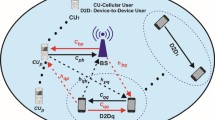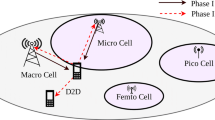Abstract
Underlay device-to-device (D2D) communication is an attractive technology enabling nearby cellular users to communicate with each other directly in order to increase data rate and spectral efficiency. The current cellular heterogeneous networks consist of macrocell base stations and small cell base stations with different transmit powers and coverage areas. Femtocell is the most popular small cell which is expected to be utilized in dense and ultra-dense scenarios in the future. Network coding in relay-assisted multi-hop communications improves achievable transmission rate and coverage of D2D communications. In this paper, two-hop random linear network coding network in cooperative D2D communication (RLNC-CDC) is considered. We propose to use femtocell base station (FBS) as a relay. We assume that the D2D pair and relay operate in the frequency band which is allocated to femtocell network. Therefore, there would be interference from the relay node and the D2D communication on the femtocell network users. To reduce the interference, the sum of transmit powers of the D2D pair and selected relay FBS should be minimized in a way that the highest transmission rate for the D2D pair is achieved. The constraints on the bounds of transmit powers of the D2D and relay node as well as the minimum required transmission rate for D2D communication are considered and the optimum solution is obtained. Simulation results indicate that the proposed RLNC-CDC achieves higher data rate and smaller outage probability than the direct D2D transmission.










Similar content being viewed by others
Explore related subjects
Discover the latest articles, news and stories from top researchers in related subjects.Abbreviations
- 5G:
-
5th generation
- AF:
-
Amplify-and-forward
- BS:
-
Base station
- CDC:
-
Cooperative D2D communication
- D2D:
-
Device-to-device
- D2D Rx:
-
D2D receiver
- D2D Tx:
-
D2D transmitter
- DDC:
-
Direct D2D communication
- DF:
-
Decode-and-forward
- FBS:
-
Femtocell base station
- FFR:
-
Fractional frequency reuse
- FUE:
-
Femtocell user equipment
- HetNet:
-
Heterogeneous network
- MBS:
-
Macrocell base station
- MUE:
-
Macrocell user equipment
- NC:
-
Network coding
- PNC:
-
Physical network coding
- RB:
-
Resource block
- RLNC:
-
Random linear network coding
- RSS:
-
Received signal strength
- SC:
-
Superposition coding
- UE:
-
User equipment
References
Doppler, K., Rinne, M., Wijting, C., Ribeiro, C. B., & Hugl, K. (2009). Device-to-device communication as an underlay to LTE-advanced networks. IEEE Communications Magazine, 47, 42–49.
Asadi, A., Wang, Q., & Mancuso, V. (2014). A survey on device-to-device communication in cellular networks. IEEE Communications Surveys and Tutorials, 16, 1801–1819.
Tehrani, M. N., Uysal, M., & Yanikomeroglu, H. (2014). Device-to-device communication in 5G cellular networks: Challenges, solutions, and future directions. IEEE Communications Magazine, 52, 86–92.
Boccardi, F., Heath, R. W., Lozano, A., Marzetta, T. L., & Popovski, P. (2014). Five disruptive technology directions for 5G. IEEE Communications Magazine, 52, 74–80.
Keller, L., Le, A., Cici, B., Seferoglu, H., Fragouli, C., & Markopoulou, A. (2012) MicroCast: Cooperative video streaming on smartphones. In Proceedings of the 10th international conference on mobile systems, applications, and services (pp. 57–70).
Chandrasekhar, V., Andrews, J. G., & Gatherer, A. (2008). Femtocell networks: A survey. IEEE Communications Magazine, 46, 59–67.
Kim, R. Y., Kwak, J. S., & Etemad, K. (2009). WiMAX femtocell: Requirements, challenges, and solutions. IEEE Communications Magazine, 47, 84–91.
Condoluci, M., Dohler, M., Araniti, G., Molinaro, A., & Zheng, K. (2015). Toward 5G densenets: architectural advances for effective machine-type communications over femtocells. IEEE Communications Magazine, 53, 134–141.
Ge, X., Tu, S., Mao, G., Wang, C.-X., & Han, T. (2016). 5G ultra-dense cellular networks. IEEE Wireless Communications, 23, 72–79.
Zhang, H., Jiang, C., Beaulieu, N. C., Chu, X., Wang, X., & Quek, T. Q. (2015). Resource allocation for cognitive small cell networks: A cooperative bargaining game theoretic approach. IEEE Transactions on Wireless Communications, 14, 3481–3493.
Zhang, H., Jiang, C., Mao, X., & Chen, H.-H. (2016). Interference-limited resource optimization in cognitive femtocells with fairness and imperfect spectrum sensing. IEEE Transactions on Vehicular Technology, 65, 1761–1771.
Okati, N., Razeghi, B., & Mosavi, M. R. (2015) On relay selection to maximize coverage region for cooperative cellular networks with multiple fixed and unfixed relays. In 2015 6th international conference on computing, communication and networking technologies (ICCCNT) (pp. 1–6).
Li, Y., Liao, C., Wang, Y., & Wang, C. (2015). Energy-efficient optimal relay selection in cooperative cellular networks based on double auction. IEEE Transactions on Wireless Communications, 14, 4093–4104.
Wang, Q., Wang, W., Jin, S., Zhu, H., & Zhang, N. T. (2015). Joint coding mode and multi-path selection for video transmission in D2D-underlaid cellular network with shared relays. In IEEE global communications conference (GLOBECOM) (pp. 1–6).
Yan, C., Yiyang, N., & Hongbo, Z. (2015). Performance for device-to-device communication with three-time-slot two-way amplify-and-forward relay protocol. China Communications, 12, 1–11.
Naderi, S., Javan, M. R. & Aref, A. (2016) Secrecy outage analysis of cooperative amplify and forward relaying in device to device communications. In 2016 24th Iranian conference on electrical engineering (ICEE) (pp. 40–44).
Ni, Y., Jin, S., Zhu, H., Shao, S., & Wong, K.-K. (2013). Pareto-optimal power allocation of device-to-device communication with two-way decode-and-forward helping relay. In International conference on wireless communications and signal processing (wcsp) (pp. 1–6).
Ni, Y., Jin, S., Tian, R., Wong, K.-K., Zhu, H., & Shao, S. (2013). Outage analysis for device-to-device communication assisted by two-way decode-and-forward relaying. In International conference on wireless communications and signal processing (WCSP) (pp. 1–6).
Shalmashi, S., & Slimane, S. B. (2014). Cooperative device-to-device communications in the downlink of cellular networks. In IEEE wireless communications and networking conference (WCNC) (Vol. 2014, pp. 2265–2270).
Ma, C., Sun, G., Tian, X., Ying, K., Yu, H., & Wang, X. (2013). Cooperative relaying schemes for device-to-device communication underlaying cellular networks. In IEEE global communications conference (GLOBECOM) (Vol. 2013, pp. 3890–3895)
Ahlswede, R., Cai, N., Li, S.-Y., & Yeung, R. W. (2000). Network information flow. IEEE Transactions on Information Theory, 46, 1204–1216.
Moubayed, A., Sorour, S., Al-Naffouri, T., & Alouini, M.-S. (2015) Collaborative multi-layer network coding in hybrid cellular cognitive radio networks. In 2015 IEEE 81st vehicular technology conference (VTC Spring) (pp. 1–6).
Chen, Y., & Sung, C. W. (2014). Resource allocation for two-way relay cellular networks with and without network coding. In IEEE international conference on communication systems (ICCS) (Vol. 2014, pp. 600–604).
Ke, X., Pingyi, F., Su, Y., & Ming, L. (2013). Network coding-aware cooperative relaying for downlink cellular relay networks. China Communications, 10, 44–56.
Thampi, A., Liew, S.-C., Armour, S., Fan, Z., You, L., & Kaleshi, D. (2016). Physical-layer network coding in two-way heterogeneous cellular networks with power imbalance. IEEE Transactions on Vehicular Technology, 65, 9072–9084.
Zhao, Y., Li, Y., Chen, X., & Ge, N. (2015). Joint optimization of resource allocation and relay selection for network coding aided device-to-device communications. IEEE Communications Letters, 19, 807–810.
Zhao, Y., Li, Y., Ding, Z., Ge, N., & Poor, H. V. (2016). A coalitional graph game framework for network coding-aided D2D communication. EURASIP Journal on Advances in Signal Processing, 2016, 1–14.
Douik, A., Sorour, S., Tembine, H., Al-Naffouri, T. Y., & Alouini, M. S. (2016). A game-theoretic framework for network coding based device-to-device communications. IEEE Transactions on Mobile Computing, 16, 901–917.
Jeon, S. W., Choi, S. W., Kim, J., & Shin, W. Y. (2016). Cellular-aided device-to-device communication: The benefit of physical layer network coding. IEEE Communications Letters, 20, 2324–2327.
Lee, J. Y., Bae, S. J., Kwon, Y. M., & Chung, M. Y. (2011). Interference analysis for femtocell deployment in OFDMA systems based on fractional frequency reuse. IEEE Communications Letters, 15, 425–427.
Series, M. (2009). Guidelines for evaluation of radio interface technologies for IMT-Advanced, ed.
Xu, C., Song, L., Han, Z., Zhao, Q., Wang, X., Cheng, X., et al. (2013). Efficiency resource allocation for device-to-device underlay communication systems: A reverse iterative combinatorial auction based approach. IEEE Journal on Selected Areas in Communications, 31, 348–358.
Castura, J., & Mao, Y. (2007). Rateless coding for wireless relay channels. IEEE transactions on wireless communications, 6, 1638–1642.
Luo, Z.-Q., & Yu, W. (2006). An introduction to convex optimization for communications and signal processing. IEEE Journal on selected areas in communications, 24, 1426–1438.
Kalbkhani, H., Solouk, V., & Shayesteh, M. G. (2015). Resource allocation in integrated femto-macrocell networks based on location awareness. IET Communications, 9, 917–932.
Kyösti, P., Meinilä, J., & Hentilä, L. (2008). WINNER II channel models, deliverable d1. 1.2 v1. 2. Information Society Technologies (September 30, 2007).
Author information
Authors and Affiliations
Corresponding author
Ethics declarations
Conflict of interest
On behalf of all authors, the corresponding author states that there is no conflict of interest.
Rights and permissions
About this article
Cite this article
Kalbkhani, H., Shayesteh, M.G. Power allocation and relay selection for network-coded D2D communication underlay heterogeneous cellular networks. Telecommun Syst 67, 699–715 (2018). https://doi.org/10.1007/s11235-017-0367-3
Published:
Issue Date:
DOI: https://doi.org/10.1007/s11235-017-0367-3




